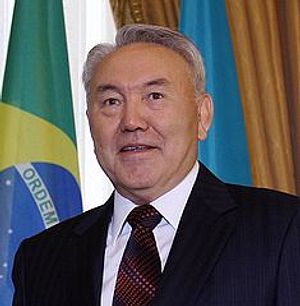In the waning days of December, Kazakhstan President Nursultan Nazarbayev has taken part in a flurry of televised events. On December 22, he appeared in the presidential palace surrounded by eight local journalists who offered up softball questions, from the description of the country’s anti-crisis strategy to the president’s favorite songs. During the ninety minute session, Nazarbayev showed great presence, a sense of humor, and a tight grip on the country’s future.
This was in stark contrast to the press conference that took place a few days later in Moscow, where the new members of the Eurasian Economic Union were presented. In front of the press, Nazarbayev appeared tired and ceremonial; admittedly, the only excited participants at the event seemed to be Belarusian president Alexander Lukashenko and his Kyrgyz counterpart Almazbek Atambayev; Armenia’s president Serzh Sargsyan and his Russian colleague Vladimir Putin also appeared inattentive.
The lack of concentration at the Eurasian meeting may have been linked to Nazarbayev’s visit to Ukraine on December 22, the day before he flew to Moscow. There, Nazarbayev met with president Petro Poroshenko and prime minister Arsenii Yatsenyuk, assuring them of Kazakhstan’s readiness to provide a forum for the dialogue needed to end the crisis with Russia. Nazarbayev’s interactions with the Ukrainian government were carried out in Russian and resonated across the post-Soviet area. Some analysts even detecting a pinch of defiance towards Russia in the Kazakhstan’s president decision to visit Ukraine before an important meeting in Moscow.
Back from his foreign trips, Nazarbayev appeared on television again during a business awards conference, on December 25. At this domestic meeting, his colloquial and energetic personality were again on display. This seems to be something of an unwritten strategy for the government of Kazakhstan: Be reluctant, monotonous and apathetic abroad – especially during televised events with Putin – but show strength and control over economic policies at home. In another example, before his busy month of December, Nazarbayev turned the dull Party convention into a full-fledged state of the nation address, unveiling his new industrialization plan “Nurly Zhol” (literally, the shining path).
Is it possible to divine any kind of message in Nazarbayev’s recent TV appearances? First, the broadcasts have been increasingly frequent, as if both the economic crisis and the need to leave a positive legacy as the leader of the nation have pushed Kazakhstan’s president to constantly talk to his fellow citizens. Second, Nazarbayev has clearly grown wary of Russia’s foreign policy stance and looks increasingly skeptical of the benefits of the new Eurasian Economic Union. In fact, his domestic and international assessments of the prospects of integration are almost identical; it is the tone that is different. And third, it could be that the difference between his TV appearances at home and abroad are a political statement: Kazakhstan will pursue a multivector foreign policy directed to the east as well as to the west, but a crisis necessitates that the leader’s attention stays focused on domestic issues.
During one of his December speeches, Nazarbayev asked that his portraits be removed outside the cities and replaced with posters highlighting Kazakhstan’s economic and technological development. Internationally, the president is reluctantly turning Kazakhstan into a broker for peace in Ukraine: The next meeting between Putin and Poroshenko is slated to be held in Astana on January 15. Inevitably, that means more TV appearances for Nazarbayev.

































